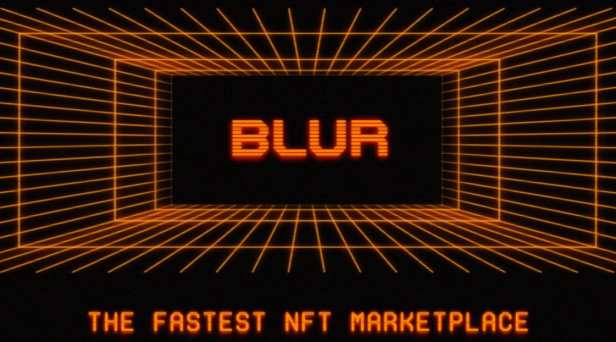
In the past three months, the NFT trading market has undergone earth-shaking changes. Blur's total trading volume has exceeded OpenSea, and almost all NFT project floor prices are listed on Blur. So, what exactly makes Blur so successful? Can its success be sustained? This article will analyze Blur’s past and present life in detail.
market environment
At the end of March 2022, an inconspicuous financing news attracted attention on Twitter. Blur successfully raised US$11 million. The lead investor was the well-known Paradigm. Other angel investors included many KOLs in the NFT field, such as Deeze and Zeneca. and 6529 etc. Although there is not much information provided in the announcement, Blur’s goal is clear: to become a professional NFT trading platform.
At this time, the NFT market is at the end of the last round of bull market. Various new blue-chip projects are emerging one after another, and new NFT trading markets are also emerging one after another. Since LooksRare started airdropping tokens to incentivize transactions, the trading model of the NFT market has fundamentally changed. X2Y2 introduced the concept of pending order incentives, which further stimulated the growth of market trading volume.
Although most of the trading volume is wash trading to earn tokens, the real traffic cannot be underestimated. According to statistics, more than 15%-20% of transaction traffic occurs on platforms other than OpenSea. This marks that the NFT market is gradually breaking away from the dominance of OpenSea and beginning to develop into diversification.
The birth of aggregation tools
The emergence of NFT aggregators meets the needs of different users. The first type of user wants to purchase a certain NFT conveniently. They can use the aggregator to quickly browse all pending NFTs and finally select their favorite work. The second type of user hopes to purchase a certain NFT project in large quantities. At this time, the advantages of aggregation tools are more obvious.
The aggregator headed by Genie once attracted a large amount of transaction volume, but was soon replaced by Gem because the latter had more advantages in user experience and information update speed. The user experience of an aggregator is very important. If the product experience is not good, users would rather go to the market to buy it directly. Therefore, the quality of user experience directly determines the market competitiveness of an aggregator.
Need for professional tools
In the NFT market, the trading volume is mostly dominated by large users, and the 3/7 law can often be applied, that is, 70% of the trading volume is in the hands of 30% of users. Therefore, the needs of this group of users have become a top priority. The experience of using aggregation tools such as Gem is not much different from that of the general trading market. The loading speed is slow, and users often miss opportunities when browsing each NFT.
NFT traders attach great importance to the timeliness of information, smooth operation and professional trading functions. The market urgently needs a more powerful aggregation tool to integrate the functions of browsing, flash sales and bulk purchases, and Blur came into being.
marketing
Since mid-2022, Blur has spread among major NFT investors, benefiting from a strong lineup of angel investors and KOLs. Subsequently, Blur launched a closed beta test of the platform and adopted an invitation system. Users scored based on their transaction data in OpenSea in the past year and invited other users to participate. The higher the score ranking, the priority will be to obtain test qualifications.
Blur was developed for professional users from the beginning, saving a lot of marketing resources. In comparison, although OpenSea has a large number of users, its transaction volume may not be comparable to Blur. Through indirect publicity through KOLs, Blur’s market influence has rapidly expanded.
Join the trading market
For aggregators, aggregation functionality alone is not profitable. Once fees are decided, many users will be unwilling to use the platform. Therefore, aggregators must serve as traffic portals to monetize other products. Gem and Genie failed to find suitable revenue streams and were eventually acquired.
Blur realized that the combination of aggregation capabilities and trading markets was the key to success. It not only provides users with the best quotes in the market, but also allows users to place orders and bids on the same platform. This strategy effectively retains users and increases the platform’s transaction revenue.
closed market
Although Blur's API is under development, the development progress is slow, resulting in the outside world being unable to connect to Blur's market liquidity, forming a system that is only in but not out. Although Blur has aggregated a large amount of bottom liquidity, it has also raised questions about its declining competitiveness.
Optional royalties battle: Blur's success is inseparable from optional royalties. The implementation of optional royalties has made Blur stand out in the market, although this policy has caused a lot of controversy. The competition between OpenSea and Blur revolves around optional royalties.
The concept of optional royalties was introduced when Blur was launched, although X2Y2 had already announced support for optional royalties as early as the end of August. This policy has sparked widespread discussion because NFT projects’ ongoing revenue largely relies on royalties from the secondary market. Many people believe that this will have a negative impact on the entire NFT ecosystem, but it is also all this that brings traffic to Blur.
in conclusion
Blur's success not only relies on airdrops and currency issuance, but also on its precise grasp of market demand and flexible strategies. Through the combination of aggregation tools and trading markets, Blur stands out in the highly competitive NFT market. In the future, whether Blur can continue to maintain this advantage still needs time to test.
In this ever-changing market, every step of Blur will receive attention, and its future development direction will also affect the direction of the entire NFT ecosystem. In any case, Blur's story continues and is worth looking forward to.